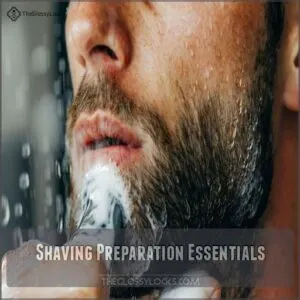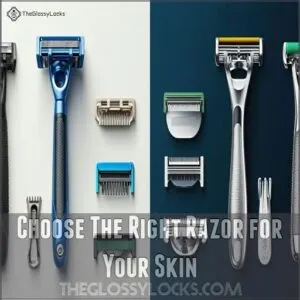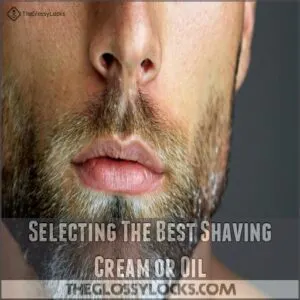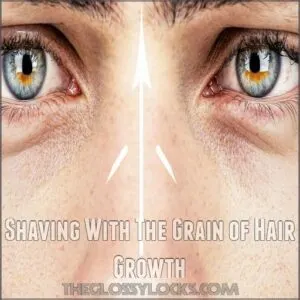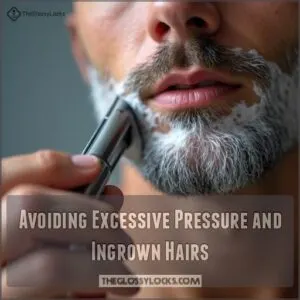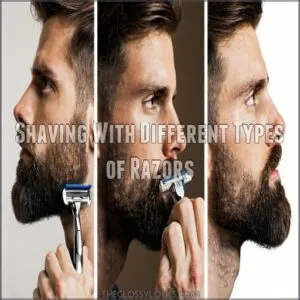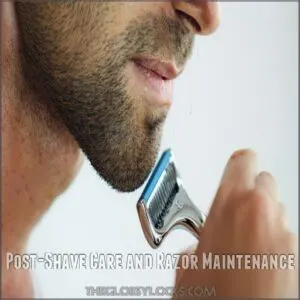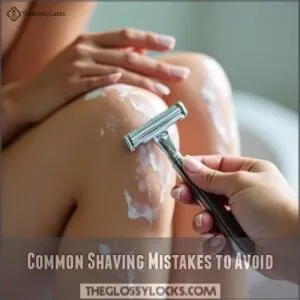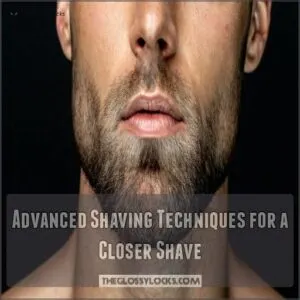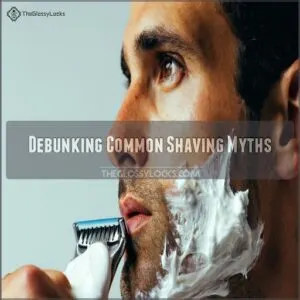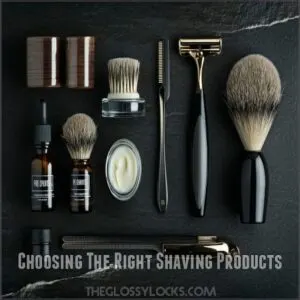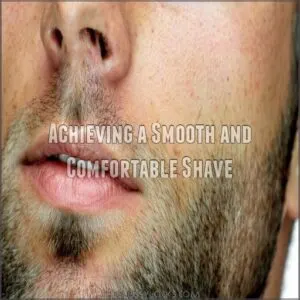This site is supported by our readers. We may earn a commission, at no cost to you, if you purchase through links.
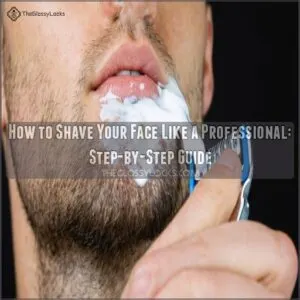
Start with proper prep – cleanse your face and soften those stubborn whiskers with warm water or a hot towel.
Choose a sharp razor that suits your skin type, and don’t skimp on quality shaving cream.
Apply gentle, short strokes with the grain of your hair growth, keeping skin taut with your free hand.
Finish up by rinsing with cool water and applying an alcohol-free aftershave balm.
Think you’re doing everything right? You might be surprised by the common mistakes that are standing between you and that perfect, barbershop-smooth result.
Table Of Contents
- Key Takeaways
- Shaving Preparation Essentials
- How to Shave Your Face Like a Pro
- Mastering Shaving Techniques
- Shaving With Different Types of Razors
- Post-Shave Care and Razor Maintenance
- Common Shaving Mistakes to Avoid
- Advanced Shaving Techniques for a Closer Shave
- Debunking Common Shaving Myths
- Choosing The Right Shaving Products
- Achieving a Smooth and Comfortable Shave
- Frequently Asked Questions (FAQs)
- Should you shave your face?
- How do I Shave my Face effectively?
- How to make a good shave?
- How do you shave a Damp Face?
- How do you shave a bald face?
- How do you shave a dry face?
- Is it better to shave up or down on face?
- Is it better to shave your face wet or dry?
- Do dermatologists recommend face shaving?
- Is it okay to shave peach fuzz on your face?
- Conclusion
Key Takeaways
- You’ll need proper preparation: cleanse your face with warm water, exfoliate dead skin cells, and apply pre-shave oil to soften hair and protect skin.
- You should always shave with the grain, using short, gentle strokes while keeping your skin taut with your free hand. This prevents irritation and ingrown hairs.
- You’ll get better results by using quality tools: invest in a sharp razor suited to your skin type and choose alcohol-free shaving cream with natural ingredients.
- You must follow up with proper post-shave care: rinse with cool water, pat dry gently, and apply alcohol-free aftershave balm to soothe and protect your skin.
Shaving Preparation Essentials
Before you even think about picking up a razor, make sure your skin is ready by cleansing your face and softening your hair with warm water.
For a smoother, irritation-free shave, exfoliate your skin to banish dead cells and follow up with a pre-shave oil to keep everything feeling just right.
Cleanse Your Face
Starting your shave with a clean face is like setting the stage for a masterpiece. Wash with a facial cleanser to remove dirt and oil. This pre-shave step lays the groundwork for a smooth glide and less irritation.
- Pick a cleanser for your skin type.
- Exfoliate for extra smoothness.
- Make it part of your routine.
Soften Hair and Open Pores
Before you grab that razor, see how softening your hair can transform your shave.
Use a hot towel treatment or a warm water rinse to coax pores open and hair to relax.
Think of it as a spa for your face, making each stroke easier. This step guarantees a sleeker, more comfortable shave, just like the pros.
Exfoliate and Use Pre-Shave Oil
Once you’ve softened your hair, it’s time to embrace exfoliation to clear away dead skin, minimizing the risk of ingrown hairs.
Think of it like decluttering a room for fresh energy.
Then, grab some pre-shave oil—it’s your secret weapon. This silky armor softens the hair and cushions your skin, reducing sensitivity and setting the stage for a professional shave.
How to Shave Your Face Like a Pro
Ready to ditch those nicks and bumps and get a truly professional shave?
We’ll show you how to choose the right razor and shaving cream for your skin type,
ensuring a smooth, irritation-free experience every time.
Choose The Right Razor for Your Skin
Choosing the right razor makes a world of difference—think of it as finding a sidekick for your shaving routine.
Whether you opt for a safety razor, cartridge, or electric, consider your skin type and sensitivity.
A sharp blade is essential; dull ones invite nicks and irritation. Match razor type with your shaving frequency to keep your face feeling fresh. A sharp blade is essential.
Selecting The Best Shaving Cream or Oil
Weighing the pros and cons of shaving cream vs. oil helps tailor your shave to your skin’s needs.
When choosing between these products, consider the various shaving cream types that cater to different skin types, such as dry, sensitive, or oily skin.
For sensitive skin, go oil; it’s gentle and often unscented. Prefer a smooth lather? Cream’s your go-to, offering a rich texture.
Consider your budget, but remember, the best shaving products guarantee a professional shave without breaking the bank.
Mastering Shaving Techniques
You’ll discover how a few simple techniques can transform your morning shave from a rushed chore into a smooth, nick-free experience.
Whether you’re using a safety razor or an electric shaver, these proven methods will help you master the art of facial grooming.
while keeping your skin happy and irritation-free.
Shaving With The Grain of Hair Growth
Shaving with the grain isn’t just a fancy term – it’s your ticket to a smoother, more comfortable shave.
Map out your facial hair growth patterns by gently running your fingers across your face.
Here’s how to become a grain-reading pro:
- Feel the direction where hair offers least resistance
- Draw arrows on a face diagram for reference
- Start at your sideburns, working downward
- Follow natural growth patterns around your neck’s curves
Applying Gentle Pressure and Short Strokes
Now that you’re following the grain, let’s master the art of pressure control.
Think of your razor like a paintbrush – light, controlled strokes create the best results.
Keep your strokes short, about two inches long, and let the razor’s weight do most of the work.
Avoiding common shaving obstacles like razor burn and ingrown hairs by shaving with a sharp blade and using warm water, as explained in shaving your beard close.
Pull your skin taut with your free hand, and glide the blade smoothly over your face like you’re spreading soft butter.
Avoiding Excessive Pressure and Ingrown Hairs
Too much pressure turns your razor into a weapon against your skin.
Keep your touch light as a feather to prevent razor burn and those pesky ingrown hairs.
Pull your skin taut with your free hand, and let the razor’s weight do the work.
If you notice redness or bumps, you’re pressing too hard. Remember, you’re stroking your face, not scrubbing a dirty pot.
Shaving With Different Types of Razors
You’ll find a world of difference between using a safety razor, straight blade, or electric shaver, and each one offers its own unique path to the perfect shave.
Whether you’re a beginner looking for the reliable comfort of a cartridge razor or an experienced shaver ready to try the classic straight razor technique,
you’ll learn how to master each type and choose the best one for your needs.
Safety Razors and Cartridge Razors
Both safety and cartridge razors offer unique advantages for your daily shave.
Safety razors deliver a closer shave with their single, sharp blade and provide better control, though they require practice to master.
While cartridge razors cost more long-term, their multiple blades and pivoting heads make them more forgiving and ideal for beginners. cartridge razors safety razors
Remember to keep your blades sharp and replace them regularly for the best results. best results
Straight Razors and Electric Shavers
Straight razors offer unparalleled control and precision, letting you master the art of the perfect shave.
For electric shavers, you’ll want to grow a bit of stubble first – about 2-3 days worth – before tackling your facial hair.
While straight razors demand careful attention to blade sharpness and technique, modern electric shavers simplify your routine with wet or dry options and built-in maintenance indicators.
Choosing The Best Razor for Your Needs
Let’s get you matched with the perfect razor for your unique needs.
When choosing between safety razors, cartridges, or electric shavers, consider your skin sensitivity, time constraints, and budget.
If you’ve got sensitive skin, try a safety razor with adjustable settings.
Busy mornings? An electric shaver might be your best bet.
For those wanting precision and control, cartridge razors offer a balance of convenience and effectiveness.
Post-Shave Care and Razor Maintenance
You’re not done with your shave until you’ve taken care of your skin and your razor, which will make the difference between a so-so shave and a great one.
Just like a chef cleans their knives after cooking, you’ll need to maintain your razor and treat your freshly-shaved face with the right products to keep both in top shape.
This will ensure a great shave.
Rinsing With Cool Water and Pat Drying
Now that you’ve finished shaving, rinse your face thoroughly with cool water.
This step closes your pores and calms any irritation from the razor.
Take a clean, soft towel and gently pat your face dry – no rough rubbing here. Your skin’s a bit sensitive after shaving, so treat it like you’d a new tattoo.
The cooling rinse helps prevent those annoying red bumps and keeps your skin happy.
Applying Aftershave and Moisturizing
After you’ve patted your face dry, it’s time to soothe and protect your freshly shaved skin.
Apply a cooling, alcohol-free aftershave balm in gentle upward strokes – your skin will thank you for skipping the traditional burning sensation.
Follow up with a light moisturizer that matches your skin type.
For sensitive skin, look for products with aloe vera or chamomile to calm any lingering irritation.
Cleaning and Maintaining Your Razor
Taking good care of your razor extends its life and keeps your shaves smooth. Here’s what experienced shavers do to maintain their tools:
- Rinse your razor thoroughly with hot water after each use to flush out hair and product buildup
- Invest in the best razor blades for a more comfortable shaving experience, then dry your blade completely with a clean towel or hairdryer
- Store your razor in a dry place, away from shower moisture
- Replace cartridge blades every 5-7 shaves or when they feel dull
Remember, a well-maintained razor isn’t just about longevity – it’s about treating your face right.
Common Shaving Mistakes to Avoid
You won’t believe how many times you’ve made simple shaving mistakes that leave your face looking like a battlefield of nicks and razor burn.
Let’s look at the most common shaving errors that might be sabotaging your morning routine and learn how to fix them for good.
Skipping Pre-Shave Preparation
Rushing through pre-shave prep is like building a house without a foundation – it’s bound to cause problems.
You’re setting yourself up for skin irritation, razor burn, and those pesky ingrown hairs when you skip this important step, especially if you have sensitive skin shaving prep.
A proper face cleanse, warm water soak, and quality shaving cream aren’t just fancy extras – they’re your ticket to a professional-level shave that’ll keep your skin happy.
Using Dull Razor Blades
While you might be tempted to squeeze a few extra shaves from that old blade, using dull razors is like trying to cut bread with a butter knife – ineffective and potentially dangerous.
Here’s why you should keep your blades sharp:
- Dull blades require more pressure, leading to razor burn and cuts
- Old razors harbor bacteria that cause infections
- Worn blades increase your risk of ingrown hairs
- Regular blade changes actually save money by preventing skin damage
Shaving Against The Grain of Hair Growth
Despite the temptation to get a closer shave, going against the grain can wreak havoc on your skin. You’re basically inviting razor burn and ingrown hairs to set up shop on your face.
Using the right shaving cream, such as one from a best shaving cream, can make a huge difference in your shaving experience.
While some guys with tough skin might get away with it, most of us need to stick to shaving with the grain first.
If you really need that extra smoothness, try a second pass across the grain instead.
Advanced Shaving Techniques for a Closer Shave
You’ve mastered the basics, and now it’s time to step up your shaving game with techniques the pros swear by.
Whether you’re looking to impress at work or want that date-night smoothness, these advanced methods will help you get the closest shave you’ve ever had.
The Three-Pass Shave Technique
Those rookie mistakes are behind you – now it’s time to level up your game with the three-pass technique.
To guarantee the best results, especially for those with thick hair, consider using a sharp razor specifically designed for thick hair.
Start by shaving with the grain using light, steady strokes.
For your second pass, go across the grain at a 45-degree angle.
If your skin can handle it, finish with an against-the-grain pass for that baby-smooth feel. Remember to re-lather between each pass.
Shaving in Sections and Adjusting for Facial Contours
To master facial mapping like a pro, break your face into distinct sections: cheeks, jawline, chin, and neck.
Start with your cheeks, using light strokes and stretching your skin taut.
When you hit the jawline, adjust your razor’s angle to follow the natural contours. For tricky spots like under your nose, puff out your cheeks and take extra care around these sensitive areas.
Your neck needs special attention – shave in upward strokes to prevent irritation.
Using a Hot Towel Treatment
A hot towel treatment is your ticket to barbershop-level luxury at home.
Soak a clean, soft towel in water that’s hot (but not scalding), wring it out, and press it gently against your face for 2-3 minutes.
This opens your pores, softens stubble, and relaxes facial muscles.
For best results, apply the towel twice – once before lathering and again after your first pass.
Debunking Common Shaving Myths
You’ve probably heard that shaving makes your facial hair grow back thicker and darker, but this common belief isn’t true at all.
Let’s clear up this and other shaving myths that might be keeping you from getting your best shave.
Shaving Does Not Make Hair Grow Back Thicker
After mastering advanced techniques, let’s bust a common myth that’s been around forever. The idea that shaving makes your hair grow back thicker is completely false.
Here’s what actually happens:
- Cut hair has a blunt edge, making it feel coarser temporarily
- New growth appears darker because it hasn’t been exposed to sun or chemicals
- Your natural hair thickness remains exactly the same
It’s all about perception rather than reality – your stubble just feels different because of how it’s cut.
You Don’t Need to Shave Every Day
Many men believe daily shaving is necessary for a polished look, but your skin might thank you for taking a break.
A consistent skin care routine before shaving can also help, as it prepares your skin for a gentle shave and reduces the risk of ingrown hairs and razor burn.
Giving your face 24-48 hours between shaves lets your skin heal, reduces razor burn, and prevents ingrown hairs.
Plus, a bit of stubble can work in your favor – it’s on-trend and gives your skin recovery time.
Listen to your skin and adjust your shaving frequency accordingly.
Choosing The Right Shaving Products
You’ll need more than just a sharp razor to get that perfect, irritation-free shave you’re looking for.
From pre-shave oils that prep your skin to soothing aftershave balms that prevent razor burn,
let’s find the products that’ll work best for your face.
Selecting a High-Quality Shaving Cream or Soap
Finding the perfect shaving cream or soap can feel like searching for a needle in a haystack, but your face deserves the best. Quality products create a rich, protective lather that lets your razor glide smoothly while preventing irritation.
- Look for natural ingredients like glycerin, shea butter, and aloe vera
- Choose between creams (easier to lather) or soaps (more economical)
- Test fragrance-free options if you have sensitive skin
Choosing The Best Pre-Shave Oil and Aftershave
Before your blade touches skin, selecting the right pre-shave oil and aftershave can make or break your shaving experience.
Look for natural oils like jojoba or argan in pre-shave products – they’ll create a protective barrier while softening stubble.
Regarding aftershave, skip the alcohol-heavy classics that sting. Instead, choose soothing balms with aloe vera and witch hazel to calm your skin and prevent irritation.
Finding The Right Razor for Your Skin Type
A razor’s compatibility with your skin can make or break your shaving experience. The right choice depends on your skin’s sensitivity and hair type, with each option offering unique benefits. If you’re unsure where to start, check out the best shaving razor options on the market best shaving razor.
- Safety razors excel for sensitive skin, providing precise control and single-blade comfort
- Electric razors work best for quick, irritation-free results on normal to tough skin
- Cartridge razors offer convenience but may irritate sensitive areas, so test carefully
Achieving a Smooth and Comfortable Shave
You’ll master the art of smooth shaving by paying attention to your skin’s needs and making small adjustments to your technique.
Whether you’re using a safety razor or an electric shaver, the key to a comfortable shave is maintaining a consistent routine that works for your face.
Practicing Patience and Persistence
Professional shaving isn’t a race to the finish line – it’s a skill you’ll master over time.
Like learning to play an instrument, you’ll hit some wrong notes at first. But stick with it.
Practice your technique each morning, focusing on maintaining consistent pressure and angle.
You’ll notice steady improvements in your results, and before you know it, you’ll be shaving like a pro.
Listening to Your Skin and Adjusting Your Technique
Your skin speaks volumes during each shave, telling you exactly what works and what doesn’t. Just like a skilled musician adjusts their technique based on the instrument, you’ll need to fine-tune your approach based on your skin’s feedback.
- Red patches signal you’re pressing too hard or using the wrong angle
- Small bumps suggest you’re shaving against the grain
- Dry, flaky areas mean it’s time to switch up your pre-shave routine
Listen carefully to these signals and adapt accordingly.
Maintaining a Consistent Shaving Routine
Now that you’re tuned into your skin’s signals, let’s make shaving a well-oiled machine.
Think of it as your daily victory lap – same time, same steps, same stellar results.
Here’s what works for different schedules:
| Frequency | Morning Routine | Evening Routine |
|---|---|---|
| Daily | Quick 5-min rinse | Hot towel prep |
| Every 2 days | Deep cleanse | Double-pass shave |
| Every 3 days | Exfoliate first | Triple-pass care |
| Weekly | Full prep ritual | Luxury treatment |
| As needed | Basic maintenance | Touch-up only |
Remember: consistency breeds excellence.
Stick to what works for you.
Frequently Asked Questions (FAQs)
Should you shave your face?
Shaving the face helps maintain a polished appearance and can boost confidence.
While it’s not mandatory, you’ll want to contemplate your personal style, workplace requirements, and skin sensitivity before making the commitment.
How do I Shave my Face effectively?
Begin with a warm water cleanse.
Apply shaving cream against the grain.
Use gentle strokes, following hair growth direction.
Rinse with cool water and finish with a soothing aftershave balm.
How to make a good shave?
For a smooth shave, prep your face with warm water.
Apply quality shaving cream.
Use gentle strokes with a sharp razor going with the grain.
Finish with cool water and moisturizer.
How do you shave a Damp Face?
Like a gentle morning mist, your face needs the right amount of moisture.
Pat warm water on your skin, then apply shaving cream in upward strokes.
You’ll get a smoother glide without irritation.
How do you shave a bald face?
Wet your face with warm water.
Apply shaving cream generously.
Use gentle downward strokes with a sharp razor, working systematically from cheeks to neck, rinsing frequently.
Follow with cold water and moisturizer.
How do you shave a dry face?
Dry shaving can feel like sandpaper on silk.
Don’t risk it – apply warm water and shaving cream first.
If you must go dry, use an electric razor and stretch your skin taut to minimize irritation.
Is it better to shave up or down on face?
Start shaving downward with your facial hair’s natural growth pattern to minimize irritation.
You can make a second pass upward for an extra-close shave, but be gentle to avoid razor burn and ingrown hairs.
Is it better to shave your face wet or dry?
Ever wondered about the perfect shave?
A wet shave with warm water softens your beard and opens pores, giving you the closest, smoothest results.
Dry shaving can work with electric razors but risks irritation.
Do dermatologists recommend face shaving?
Most dermatologists recommend face shaving as it provides gentle exfoliation and removes dead skin cells.
You’ll want to use proper techniques and quality products to minimize irritation and maximize skin benefits.
Is it okay to shave peach fuzz on your face?
Smooth as silk – you can safely shave facial peach fuzz.
It won’t grow back thicker or darker, and you’ll love how it creates a flawless canvas for makeup.
while keeping your skin feeling baby-soft.
Conclusion
Learning how to shave your face like a professional might seem challenging at first, but it’s worth mastering these techniques for a comfortable, irritation-free experience.
By following proper preparation, using the right tools, and maintaining good technique, you’ll transform your daily shave from a chore into a rewarding ritual.
Remember, everyone’s skin and hair are different, so don’t be afraid to adjust these methods to suit your needs.
With practice and patience, you’ll achieve that perfect professional shave every time.

